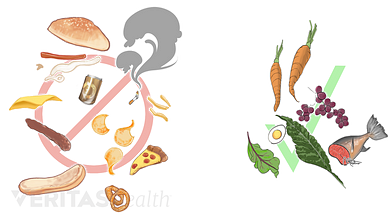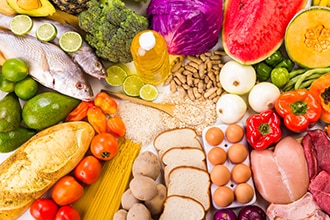
Many healthy foods are filling and delicious. They will give you delicious, nutrient-rich foods that taste great. These foods include fruits, vegetables and nuts as well as seeds, legumes, and seeds. They are also very tasty and require little preparation. Apples are a great choice because they are rich in fiber, vitamin C and antioxidants. They're also easy to find in grocery stores and can easily be added as a flavoring to smoothies.
Prunes can also help maintain a healthy digestive system. They are rich in fibre and antioxidants, which makes them great for your body. A quarter cup contains 104 calories, and 12% fiber. You can add them to your cereals, smoothies, and baked goods. They can be added to sauces, hummus, and other dishes. This makes them a wonderful snack to add into your diet. They are delicious and easy to obtain.
Moreover, you can choose a variety of starchy vegetables. These include carrots, beets, squash, corn, pumpkin, and sweet potatoes. These foods are rich in fiber and provide energy. They also contain significant amounts of B- and zinc. They're great for your body and are also rich in iron and calcium. When you make them at home, compare their nutritional values with other brands.

You can also have grilled fish as an alternative to salad. Some of the best types of fish to eat are salmon, trout, mackerel, herring, sardines, tuna, and mackerel. They are loaded with omega-3 oils, which are important for signaling. They also reduce the risk of developing heart disease, diabetes, or cancer.
Besides fruits and vegetables, you can also eat legumes, which are high in protein and dietary fibre. These foods will keep the hunger at bay and make it easier to eat less between meals. They're also a great substitute for meat, and you can get the same amount of protein without the additional fat. Calcium-enriched alternatives are available if you don't want to eat dairy or meat. They contain 100 mgs of calcium per 100ml.
Choosing the right types of food is important. It is essential to eat fruits and veggies for good health. They are high in vitamins, nutrients, and fiber. It's important to choose the right kinds of fruit and vegetables to eat everyday. You should eat them as much as possible, because they are good for you. You should eat as many as possible.
Yogurt is another healthy food. Yogurt is an excellent breakfast option because it contains a lot of protein. It's also rich in vitamins, minerals. It's also rich in soluble fibre, which is found naturally in whole grains, fruits and vegetables. It's important to mix the different types of foods to make them more interesting. Some people prefer tea, while some prefer coffee. Although coffee may not be as widely loved as tea, it does have many health benefits. It can improve energy levels, and reduce the risk of developing type II diabetes.

People should also eat more vegetables and fruits. Beans are low in fat and high in protein. They are also good sources of potassium, magnesium and fiber. They're also rich sources of plant-based protein. In addition, they're inexpensive. They can be used as side dishes and in salads. However, it's important to remember that too many people don't consume enough beans.
The most important food to eat every day is beans and seeds. They are high in phytonutrients as well fiber and vitamins B. They are also affordable. They can even help with weight loss and maintaining a healthy weight. You will have a wider variety of healthy foods available to you every day. If you can afford to, try to eat them in small portions. They are delicious, filling, and easy to make.
FAQ
What's the difference of a calorie versus a Kilocalorie?
Calories are units used to measure the amount of energy in food. Calories is the unit of measurement. One calorie equals one degree Celsius of energy to raise water temperature by 1 gram.
Kilocalories are another term for calories. Kilocalories can be measured in thousandsths of one calorie. 1000 calories equals 1 kilocalorie.
These are 5 ways you can live a healthy and happy life.
Living a healthy lifestyle includes eating right, exercising regularly, getting enough sleep, managing stress, and having fun! Avoiding sugar and processed foods is key to eating well. Exercise can help you burn calories and strengthen your muscles. Sleeping enough is good for memory and concentration. Stress management helps reduce anxiety and depression. Fun keeps us happy and healthy.
What are 7 tips for a healthy and happy life?
-
Take care of your health
-
Exercise regularly
-
Sleep well
-
Get plenty of water.
-
Get enough rest
-
Happy!
-
Smile often.
Statistics
- nutrients.[17]X Research sourceWhole grains to try include: 100% whole wheat pasta and bread, brown rice, whole grain oats, farro, millet, quinoa, and barley. (wikihow.com)
- In both adults and children, the intake of free sugars should be reduced to less than 10% of total energy intake. (who.int)
- WHO recommends reducing saturated fats to less than 10% of total energy intake; reducing trans-fats to less than 1% of total energy intake; and replacing both saturated fats and trans-fats to unsaturated fats. (who.int)
- According to the Physical Activity Guidelines for Americans, we should strive for at least 150 minutes of moderate intensity activity each week (54Trusted Source Smoking, harmful use of drugs, and alcohol abuse can all seriously negatively affect your health. (healthline.com)
External Links
How To
What does "vitamin" actually mean?
Vitamins can be described as organic compounds found in food. Vitamins are essential for our bodies to absorb nutrients from the foods we eat. Vitamins are not made by the body, so they must be obtained through food.
There are two types vitamins: water soluble or fat soluble. Water-soluble vitamins dissolve in water easily. Some examples include vitamin C,B1 and B2 vitamins (thiamine), B2 and riboflavin, B3 and B6 vitamins (niacin), folic acids, biotin, pantothenic acids, and cholesterol. Fat-soluble vitamins can be stored in the liver or in fatty tissue. These include vitamin D, E and K, as well as beta carotene.
Vitamins can be classified by their biological activity. There are eight major categories of vitamins.
-
A – Essential for normal growth, and the maintenance of good health.
-
C - essential for nerve function and energy generation.
-
D - essential for healthy bones, teeth, and gums.
-
E - needed for good vision and reproduction.
-
K - essential for healthy muscles, nerves, and bones.
-
P – vital for building strong bones.
-
Q - aids digestion, absorption and absorption iron
-
R - necessary for making red blood cells.
The recommended daily allowance (RDA) of vitamins varies depending on age, gender, and physical condition. The U.S. Food and Drug Administration, (FDA), sets the RDA value.
For adults 19 years and over, the RDA of vitamin A is 400mg per day. However, pregnant women need 600 micrograms per day because it is important for fetal development. Children ages 1-8 require 900 micrograms per day. For infants younger than one year, 700 micrograms are required daily. However, this number drops to 500 micrograms each day for children aged 9-12 months.
Children aged 1-18 years need 800 micrograms daily, while children overweight require 1000 micrograms per days. Children who are severely obese or underweight will need 1200 micrograms each day.
Children 4-8 years old who have anemia must consume 2200 micrograms of Vitamin C daily.
2000 micrograms is the minimum daily intake for adults over 50 years old to maintain good health. Mothers who are pregnant, nursing, or have a high nutrient need will require 3000 micrograms a day.
Adults over 70 years of age need 1500 micrograms per day since they lose about 10% of their muscle mass each decade.
Women who are pregnant, nursing or breastfeeding need more than the RDA. Pregnant mothers need 4000 micrograms per daily during pregnancy and 2500 after giving birth. Breastfeeding moms need 5000 micrograms each day when breastmilk production occurs.